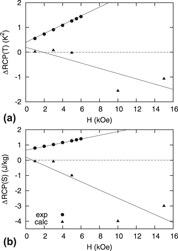Crossref Citations
This article has been cited by the following publications. This list is generated based on data provided by
Crossref.
Franco, V.
Blázquez, J.S.
Ipus, J.J.
Law, J.Y.
Moreno-Ramírez, L.M.
and
Conde, A.
2018.
Magnetocaloric effect: From materials research to refrigeration devices.
Progress in Materials Science,
Vol. 93,
Issue. ,
p.
112.
Mikhaleva, E. A.
Flerov, I. N.
Kartashev, A. V.
Gorev, M. V.
Molokeev, M. S.
Korotkov, L. N.
and
Rysiakiewicz-Pasek, E.
2018.
Specific Heat and Thermal Expansion of Triglycine Sulfate–Porous Glass Nanocomposites.
Physics of the Solid State,
Vol. 60,
Issue. 7,
p.
1338.
Yen, Pham Duc Huyen
Dung, Nguyen Thi
Thanh, Tran Dang
and
Yu, Seong-Cho
2018.
Magnetic properties and magnetocaloric effect of Sr-doped Pr0.7Ca0.3MnO3 compounds.
Current Applied Physics,
Vol. 18,
Issue. 11,
p.
1280.
Fkhar, L
El Maalam, K
Hamedoun, M
El Kenz, A
Benyoussef, A
Lachkar, P
Hlil, E-K
Mahmoud, A
Boschini, F
Ait Ali, M
and
Mounkachi, O
2020.
Magnetocaloric effect and electrical properties of (0.95)La0.45Nd0.25Sr0.3MnO3/(0.05)CuO composites.
Materials Research Express,
Vol. 7,
Issue. 6,
p.
066102.
Koner, Sougata
Deshmukh, Pratik
Ahlawat, Anju
Singh, Rashmi
Majumder, S. K.
and
Satapathy, S.
2022.
Effect of interface coupling between polarization and magnetization in La0.7Pb0.3MnO3 (LPMO)/P(VDF-TrFE) flexible nanocomposite films.
Journal of Materials Science,
Vol. 57,
Issue. 15,
p.
7621.
Koner, Sougata
Satapathy, S.
Deshmukh, Pratik
Sharma, R.K.
Sahoo, Pratap K.
and
Majumder, S.K.
2023.
Intercorrelations of structural-magnetic properties of La0.7A0.3MnO3 (A=Ba, Sr, Pb) manganites and the energy harvesting applications of their flexible nanocomposite films.
Journal of Alloys and Compounds,
Vol. 968,
Issue. ,
p.
172249.
Amirov, Abdulkarim A.
Anokhin, Alexander S.
Talanov, Mikhail V.
Sokolovskiy, Vladimir V.
Kutzhanov, Magzhan. K.
Huang, Houbing
Reznichenko, Larisa A.
Es’kov, Andrey V.
and
Aliev, Akhmed M.
2023.
Multicaloric Effect in 0–3-Type MnAs/PMN–PT Composites.
Journal of Composites Science,
Vol. 7,
Issue. 9,
p.
400.
Mansouri, Moufida
Amirov, Abdulkarim
Messaoudi, Olfa
Manai, Leila
Elgharbi, Sarra
and
Alfhaid, Latifah
2023.
Magnetocaloric Effect in La0.7Pb0.3-xBaxMnO3 (x = 0.05, 0.10, and 0.15): Direct and Indirect Measurements.
Journal of Superconductivity and Novel Magnetism,
Vol. 36,
Issue. 1,
p.
171.
Zainuddin, M.A.I.
Rozilah, R.
Ibrahim, N.
and
Mohamed, Z.
2024.
The modifications in structural, optical, and electro-magnetic phase transition of Vanadium-doped La-based manganite ceramics La0.7Pb0.3Mn1−yVyO3 (y = 0 – 0.1).
Journal of Alloys and Compounds,
Vol. 976,
Issue. ,
p.
173225.
